Archives
- August 2024
- September 2023
- August 2023
- July 2023
- April 2023
- January 2023
- December 2022
- November 2022
- October 2022
- August 2022
- June 2022
- May 2022
- April 2022
- March 2022
- February 2022
- January 2022
- November 2021
- October 2021
- September 2021
- August 2021
- July 2021
- April 2021
- March 2021
- February 2021
- October 2020
- September 2020
- July 2020
- April 2020
- March 2020
- February 2020
- January 2020
- November 2019
- September 2019
- August 2019
- July 2019
- June 2019
- May 2019
- April 2019
- February 2019
- January 2019
- December 2018
- November 2018
- October 2018
- September 2018
- August 2018
- June 2018
- May 2018
- April 2018
- March 2018
- January 2018
- December 2017
- November 2017
- October 2017
- August 2017
- July 2017
- June 2017
- May 2017
- April 2017
- March 2017
- February 2017
- December 2016
- November 2016
- October 2016
- September 2016
- August 2016
- July 2016
- June 2016
- May 2016
- April 2016
- March 2016
- February 2016
- January 2016
- December 2015
- November 2015
- October 2015
- September 2015
- August 2015
- July 2015
- June 2015
- May 2015
- April 2015
- March 2015
- February 2015
- January 2015
- December 2014
- November 2014
- October 2014
- September 2014
- August 2014
- July 2014
- June 2014
- May 2014
- April 2014
- March 2014
- February 2014
- January 2014
- December 2013
- November 2013
- October 2013
- September 2013
- August 2013
- July 2013
- June 2013
- May 2013
- April 2013
- March 2013
- February 2013
- January 2013
- December 2012
- November 2012
- October 2012
- September 2012
- August 2012
- July 2012
- June 2012
- May 2012
- April 2012
- March 2012
- February 2012
- January 2012
- December 2011
- November 2011
- October 2011
- September 2011
- August 2011
- July 2011
- June 2011
- May 2011
- April 2011
- March 2011
- February 2011
- January 2011
- December 2010
- November 2010
- October 2010
- September 2010
- August 2010
- July 2010
- June 2010
- May 2010
- April 2010
- March 2010
- February 2010
- January 2010
- December 2009
- November 2009
- October 2009
- September 2009
- August 2009
- July 2009
- June 2009
- May 2009
- April 2009
- March 2009
- February 2009
- January 2009
- December 2008
- November 2008
- October 2008
- September 2008
- August 2008
- July 2008
- June 2008
- May 2008
- April 2008
- March 2008
- February 2008
- January 2008
- December 2007
- November 2007
- October 2007
- September 2007
- August 2007
- July 2007
- June 2007
- May 2007
- April 2007
- March 2007
- February 2007
- January 2007
“William Shatner’s Get a Life!” documentary
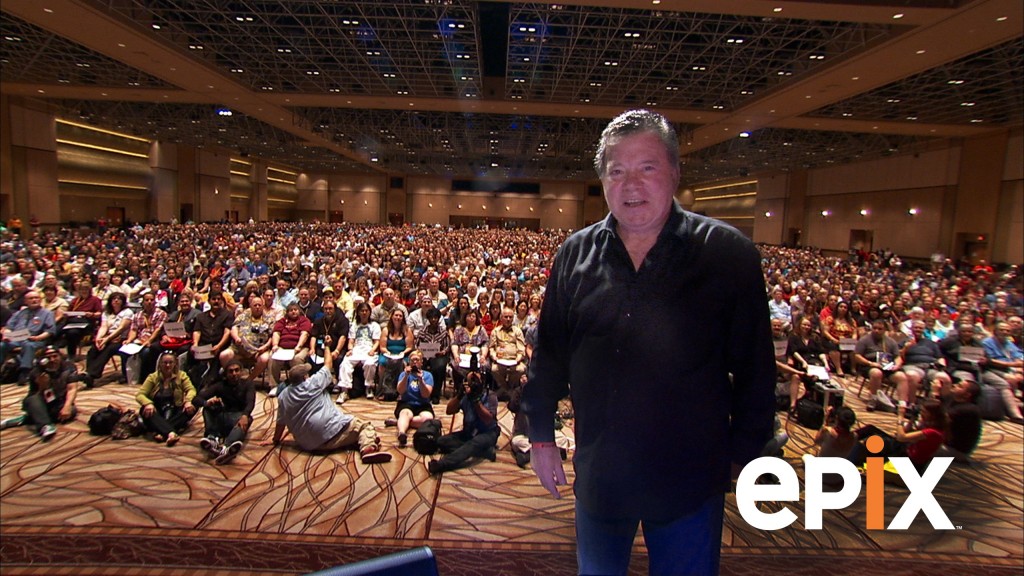 For a while now I’ve been waiting to see the William Shatner’s Get a Life! documentary. This film is part of the EPIX Originals series, and Shatner serves as one of the executive producers. He also wrote and directed this piece. After doing his documentary The Captains as part of a process of self-discovery, this was his next project, but one that is qualitatively different. Captains was a cathartic process of coming to grips with the character of Capt. Kirk by way of reflection on the other captains in the franchise. It was also, interestingly, a way of embracing the twilight of life. But William Shatner’s Get a Life! represents a process of trying to understand the intense devotion of fans to the mythology after over 45 years. Although Shatner explored some of this previously in his book Get a Life!, this documentary is the actor’s attempt at understanding the topic for himself in more depth, and for the fans whose lives he considers along the way.
For a while now I’ve been waiting to see the William Shatner’s Get a Life! documentary. This film is part of the EPIX Originals series, and Shatner serves as one of the executive producers. He also wrote and directed this piece. After doing his documentary The Captains as part of a process of self-discovery, this was his next project, but one that is qualitatively different. Captains was a cathartic process of coming to grips with the character of Capt. Kirk by way of reflection on the other captains in the franchise. It was also, interestingly, a way of embracing the twilight of life. But William Shatner’s Get a Life! represents a process of trying to understand the intense devotion of fans to the mythology after over 45 years. Although Shatner explored some of this previously in his book Get a Life!, this documentary is the actor’s attempt at understanding the topic for himself in more depth, and for the fans whose lives he considers along the way.
This film is similar to other documentary explorations of the Star Trek phenomenon, such as Trekkies, in that it devotes large segment of the documentary to portraits of various fans and showing the depth to which the Trek mythology has impacted them. This is important as the foundation for the analytical portion of the film as it attempts to answer why people like this are so enamored with the franchise, and in such deep ways. But in my view, this documentary would have been strengthened had it spent less time portraying the lives of various fans, and spent more time by way of analysis.
After laying a foundation in Trek fandom the film then begins its reflections on the meaning of this phenomenon. The analysis is interspersed periodically in the remainder of the documentary amidst the personal stories of various fans. In order to find out what Star Trek means, Shatner turns to Richard Imon who teaches Liberal Arts at Regis University. Imon uses Star Trek in his course work, and draws upon the theoretical framework of Joseph Campbell in terms of the human psyche and myth. After introducing this interpretive method Shatner then turns to Robert Walter who is President of the Joseph Campbell Foundation. For those familiar with Campbell’s work, whether through his books or the Joseph Campbell and the Power of Myth program on PBS where he was interviewed by Bill Moyers, the viewer learns little that is new. Walter explains that Star Trek functions as a powerful mythology from which people craft their own personal narratives and live this in various ways, from the hope of a united humanity, to its ethical framework, to performative and ritual aspects. This seems fairly obvious, even without the insights of Campbell’s mythological understanding, but is there more we might tease out?
In my view Shatner missed an opportunity to learn much more about the meaning of Star Trek. Not only could critical considerations related to Campbell’s view of myth been brought out, but other aspects could have been explored beyond that of the late great mythologist. Shatner could have considered some of the academic work on the ethics of Star Trek, the implications of participatory culture and performance art, convention attendance as a parallel for some fans by way of religious pilgrimage, and the various sacred aspects of science fiction and the Star Trek mythos in particular. In short, Shatner could have moved beyond the obvious in Star Trek being a significant mythology, to a consideration of whether it has become a religious phenomenon. This may seem out of bounds, but as Gary Laderman has noted, we need to expand our concepts of the sacred. Instead of formal and more traditional definitions of religion and religious institutions, Laderman suggests this is not the best way to understand the current religious landscape:
So what if the sacred is not only, or even primarily, tied to theology or religious identity labels like more, less, and not religious? We might see how religious practices and commitments emanate from unlikely sources today: science and the pursuit of truth; music and the social ecstasy of concerts; violence and the glorification of warfare; celebrity worship and technological wonders; heroic doctors and evil villains; funereal spectacles and sexual compulsions; the Super Bowl and sacrificed soldiers; Elvis and drugs, both legal and illegal.
If present experiences with the sacred have moved beyond the more traditional and familiar boundaries of the past, perhaps it wouldn’t be a stretch to add science fiction conventions, especially Star Trek conventions, as an unlikely source of the sacred in the 21st century.
This documentary will be of interest to those who want an initial exposure to reflecting on the meaning of Star Trek. But for those with more than a basic background in Trek studies, the film represents a missed opportunity to explore the mythos in more depth by drawing upon alternative interpretative possibilities. I recommend this documentary for general Star Trek fans, but for the well-read fan and the scholar, it is best to look elsewhere for fresh and deep insights on the Star Trek universe.
William Shatner’s Get a Life! is available through EPIX.
Kahless and The Postmodern Faith of Star Trek: The Next Generation
 BBC America has become one of my favorite channels since it features heavy does of science fiction programming. On Saturday afternoons it has given me an opportunity to watch episodes of Star Trek: The Next Generation and to look at them more closely than I have in the past. Recently I watched the episode “Rightful Heir,” and was struck by the way in which it presented a very postmodern way of dealing with religion, and also incorporated a combination of the skepticism and anti-religious views of Gene Roddenberry, as well as critical and postmodern expressions of religion.
BBC America has become one of my favorite channels since it features heavy does of science fiction programming. On Saturday afternoons it has given me an opportunity to watch episodes of Star Trek: The Next Generation and to look at them more closely than I have in the past. Recently I watched the episode “Rightful Heir,” and was struck by the way in which it presented a very postmodern way of dealing with religion, and also incorporated a combination of the skepticism and anti-religious views of Gene Roddenberry, as well as critical and postmodern expressions of religion.
“Rightful Heir” focuses on the crisis of faith suffered by Lt. Worf who is found in his quarters in a meditative state, surrounded by burning candles and incense. These actions are Worf’s attempt at reconnecting with his Klingon religion that involves a belief in the return of Kahless, a prophetic and messianic figure who initially brought the Klingon Empire together long ago, and who promised one day to return.
Worf receives permission to take a break from his duties in order to resolve his spiritual crisis. He makes a pilgrimage to the Temple of Boreth and performs a ceremony in a cave. To his astonishment, out of the smoke and darkness Kahless emerges, seemingly fulfilling the prophecies and resolving Worlf’s spiritual crisis. The presence of Kahless also holds great potential to unify a splintering Klingon Empire, divided by political and military rivalries, and hovering on the brink of war. But leadership factions of the Empire are at odds with each other, and Chancellor Gowron is not prepared to hand over his authority based upon Worf’s spiritual experience in the cave.
Scientific testing is done on Kahless’ DNA, and it is a match to genetic material left on a weapon from the Kahless of the past. In addition, Kahless has the memories of the great stories and events that he is known for in Klingon history and myth. Even so, Gowron remains skeptical, and he challenges Kahless to combat, easily defeating the greatest warrior among the Klingon people. In so doing, Gowron falsifies the claims of Kahless. It is later revealed that this Kahless is a clone, created using DNA from the first Kahless by Koroth the High Priest and his associates, and implanted with memories so that he could serve as the religious and political figure that might unite the Empire.
With the discovery that his religious experience was based upon fraud, Worf’s crisis of faith is renewed once again. He discusses this with Lt. Cmdr. Data, who describes a similar crisis of his own in the past. He reveals that in order to resolve his crisis he chose to transcend the dilemma by making a “leap of faith,” holding to a belief that was contradicted by the known facts. After reflecting on this, Worf takes his own leap of faith, recognizing that the clone is not the first Kahless that Klingon religion prophesied to return. Nevertheless, the decision is made by Worf and the leadership of the Empire to give allegiance to the Kahless clone as the spiritual and mythical figure who can unite a fragmented Klingon people.
I have previously written about the skepticism of Gene Roddenberry, the creator of Star Trek, who was no fan of organized religion. His views were incorporated in the original television series where humanity is depicted as having grown beyond the need for God and religion in the 23rd century, and various episodes of the series use the religiosity of alien cultures as a forum for critiquing this superstition in favor of the enlightened view of Roddenberry’s humanism (e.g., “The Return of the Archons,” and “The Apple”). This skeptical and even hostile stance toward religion continued into the next incarnation of the Star Trek mythology with Star Trek: The Next Generation. Although religion would be interacted with more positively as future incarnations of the franchise developed, particularly with Star Trek: Deep Space Nine, nevertheless, a critical posture toward religion was a major element of Star Trek in the various television series and one of the films (Star Trek V: The Final Frontier). In the Star Trek mythical universe, The Next Generation was particularly critical of religion, and “Rightful Heir” is a good example of this stance.
It should be noted that elements of this episode offer religious critique particularly in connection with two major religions traditions, Islam and Christianity. Worf has an allegedly spiritual experience while meditating in a cave, which brings to mind the experiences of Islam’s Prophet Muhammed who claimed to be visited by the angel Gabriel while praying in the cave of Hira near Mecca. Worf’s hopes for the return of Kahless parallels the Christian belief in the Second Coming of Christ. So while “Rightful Heir” portrays the credibility struggles of Klingon religion in the future, its sights are more immediately related to terrestrial religion of our time.
The interesting thing about this episode is the way in which it utilizes religion for pragmatic purposes. In keeping with Enlightenment skepticism and modernity, the truth of literal interpretations of religion is out of bounds. Religion may appear to have some value to individuals, but skepticism is the correct posture, and at the end of the day religion will be shown to be fraudulent. For those who have a personal connection to religion as a source of meaning and inspiration, this breakdown of religion, the collapse of the “sacred canopy” as sociologist Peter Berger termed it, causes a crisis of faith. But rather than jettisoning religion completely as Roddenberry’s atheism advocates, instead “Rightful Heir” takes a postmodern stance toward religion. While we must be skeptical of all overarching stories to explain reality, all metanarratives, nevertheless, we all need personal narratives to give us meaning. In this context, what is important is personal application and function rather than questions of absolute truth, which cannot be determined anyway. In the context of “Rightful Heir,” taking the advice of Data, Worf decides that even though the literal truth of his religion is fraudulent, it can still serve some important function, not only for him, but for others in the Klingon Empire as well.
Worf finds surprising support in his views of Kahless in the figure of the cloned Kahless himself. At the conclusion of this episode Kahless says to Worf:
“Kahless left us, all of us, a powerful legacy. A way of thinking and acting that makes us Klingon. If his words hold wisdom and his philosophy is honorable, what does it matter if he returns? What is important is that we follow his teachings. Perhaps the words are more important than the man.” — Kahless (clone)
Here we find an overlap between postmodern spirituality and more liberal approaches to traditional religiosity. As the argument goes, even if more literal understandings of religion are untenable or proven false, it still has value, at least in the areas of ethics and mythic narrative. In other words, even if Gabriel did not appear to Muhammed, and Jesus did not rise from the dead with a promise of a future appearing, these religions still have some value for people and cultures in our time.
I will let the reader come to their own conclusions on this and whether atheism, liberalism or postmodernity presents the appropriate stance toward such questions. What I find of interest is that one of the most popular and enduring of science fiction franchises interacted with religion, and did so in the way that it did, eschewing religion in one sense, and yet retaining its value in another. It remains to be seen whether Star Trek will engage religion again in the future, but as I have noted previously, although it has skeptical and hostile stances toward religion, it has ironically become something of a religion itself among its fandom, through its optimistic humanism, the ethic of Infinite Diversity in Infinite Combination, and attendance at conventions functioning as religious pilgrimage for the faithful. Hopefully the Great Bird of the Galaxy would not protest too much.
Call for Papers – Contemporary Horrors: Destabilizing a Cinematic Genre
 Contemporary Horrors: Destabilizing a Cinematic Genre
Contemporary Horrors: Destabilizing a Cinematic Genre
The University of Chicago, April 25-26, 2014
Keynote: Adam Lowenstein (Univ. of Pittsburgh)
The turn of the millennium has witnessed a uniquely dazzling upsurge in cinematic production within the horror genre. How do we account for the prolific production and prodigious diffusion of horror film since the turn of this last century? From thematic topoi to cinematographic style, horror cinema of the past 10-15 years has witnessed numerous trends emerge, cross-pollinate internationally, and re-enter the genre in cycles of repetition and transformation accelerated by digital production and distribution technologies. And yet, the sheer proliferation and remarkable diversity of vital horror filmmaking makes defining the genre perhaps more challenging than ever before.
In the 21st century, as horror cinema has become more clearly than ever a global genre, those films that find their way to U.S. movie theaters represent only a small fraction of the total quantity made. Just as the vast majority of horror filmmaking now occurs independently of major studio support, practices of distribution and viewing have expanded and evolved with the internet making this impressive range of films available to fans around the world. One is left to question how structures of global information and capital (and strategies for evasion of such structures), affect the form and function of filmic negotiations of horror. In other words: What delineates horror as a genre in the 21st century? How have shock, fear, and the fantastic been defined in recent horror productions? If horror has become somehow an almost “universal” idiom of global experience, what unifies our senses of trauma? How are memory and melancholy supplanted by obscenity and anxiety? To engage these and other questions, we welcome speakers who take diverse paths toward contemplation of the contemporary horror film and the questions it raises as a transnational cinematic genre. Adam Lowenstein, Professor of Film Studies at the University of Pittsburgh and author of Shocking Representation: Historical Trauma, National Cinema, and the Modern Horror Film, will provide the keynote. Topics that may be considered include but are not limited to:
– Gore and images of violence; body horror; torture porn/spectacle horror
– Auteurs and auteurist approaches to genre; alternative collaborationist approaches
– The significance of horror within contexts of national cinemas and the significance of national contexts for understanding international horror
– Transnationalism and border-crossings (international co-productions, émigré filmmakers, transnational influences)
– Remakes and genre formulae; translating and transducing horror across cultures and time
– New forms/patterns of distribution and spectatorship; Methods of advertising and publicity
– Queerness and gender issues in horror; the legacy of Carol Clover, Linda Williams, Robin Wood in horror criticism
– The relationship of art-house cinema to genre (i.e. Haneke, Del Toro, Von Trier, Denis)
– Monsters and monstrosity in the digital age
– The “found footage” film (Paranormal Activity, [REC], Cloverfield, etc.); “home movies” and the unheimlich
– Media in horror and “haunted media”; outdated medial artefacts between nostalgia and fear; the afterlife of formats
– Models for independent production
– The eroticization of the monstrous and the abject
– Technologies of horror and horrific technics: instruments of para-transmission
– Horrified psyches: anxiety, melancholy, depression, and affective models
– Horror as Event
– Speculative realism at the movies: the object’s ontology in the horror film.
Abstracts of a maximum of 200-250 words are due no later than February 1, 2014 by email to contemporaryhorrors.uchicago@gmail.com.
Titles of Interest: Avatar and Nature Spirituality
![]() Previously TheoFantastique has engaged various facets of Avatar, including its incorporation of psychedelics and shamanism, its similarities to a new religious movement, utopianism, and its involvement with Dark Green Religion. In regards to the latter element I interacted with the work of Bron Taylor, and with this post I am pleased to mention a new volume, Avatar and Nature Spirituality (Wilfred Laurier University Press, 2013), edited by Dr. Taylor.
Previously TheoFantastique has engaged various facets of Avatar, including its incorporation of psychedelics and shamanism, its similarities to a new religious movement, utopianism, and its involvement with Dark Green Religion. In regards to the latter element I interacted with the work of Bron Taylor, and with this post I am pleased to mention a new volume, Avatar and Nature Spirituality (Wilfred Laurier University Press, 2013), edited by Dr. Taylor.
Avatar and Nature Spirituality explores the cultural and religious significance of James Cameron’s film Avatar (2010), one of the most commercially successful motion pictures of all time. Its success was due in no small measure to the beauty of the Pandoran landscape and the dramatic, heart-wrenching plight of its nature-venerating inhabitants. To some audience members, the film was inspirational, leading them to express affinity with the film’s message of ecological interdependence and animistic spirituality. Some were moved to support the efforts of indigenous peoples, who were metaphorically and sympathetically depicted in the film, to protect their cultures and environments. To others, the film was politically, ethically, or spiritually dangerous. Indeed, the global reception to the film was intense, contested, and often confusing.
To illuminate the film and its reception, this book draws on an interdisciplinary team of scholars, experts in indigenous traditions, religious studies, anthropology, literature and film, and post-colonial studies. Readers will learn about the cultural and religious trends that gave rise to the film and the reasons these trends are feared, resisted, and criticized, enabling them to wrestle with their own views about the film and the controversy. Like the film itself, Avatar and Nature Spirituality provides an opportunity for considering afresh the ongoing struggle to determine how we should live on our home planet, and what sorts of political, economic, and spiritual values and practices would best guide us.
Bron Taylor is a professor at the University of Florida and a fellow of the Rachel Carson Center in Munich, Germany. His books include Dark Green Religion: Nature Spirituality and the Planetary Future (2010), and he is the editor of the award-winning Encyclopedia of Religion and Nature (2005) and the Journal for the Study of Religion, Nature and Culture. His website is www.brontaylor.com.
Table of Contents for
Avatar and Nature Spirituality, edited by Bron TaylorPART I BRINGING AVATAR INTO FOCUS
Prologue: Avatar as Rorschach | Bron Taylor
Introduction: The Religion and Politics of Avatar | Bron Taylor
Avatar: Ecorealism and the Blockbuster Melodrama | Stephen Rust
Outer Space Religion and the Ambiguous Nature of Avatar’s Pandora | Thore Bjørnvig
PART II POPULAR RESPONSES
Avatar Fandom, Environmentalism, and Nature Religion | Britt Istoft
Post-Pandoran Depression or Na’vi Sympathy: Avatar, Affect, and Audience Reception | Matthew Holtmeier
Transposing the Conversation into Popular Idiom: The reaction to Avatar in Hawai’i | Rachelle K. Gould, Nicole M. Ardoin, and Jennifer Kamakanipakolonahe’okekai Hashimoto
Watching Avatar from “AvaTar Sands” Land | Randolph Haluza-Delay, Michael P. Ferber, and Tim Wiebe-Neufeld
PART III CRITICAL, EMOTIONAL & SPIRITUAL REFLECTIONS
Becoming the “Noble Savage”: Nature Religion and the “Other” in Avatar | Chris Klassen
The Na’vi as Spiritual Hunters: A Semiotic Exploration | Pat Munday
Calling the Na’vi: Evolutionary Jungian Psychology and Nature Spirits | Bruce MacLennan
Avatar and Artemis: Indigenous Narratives as Neo-Romantic Environmental Ethics | Joy H. Greenberg
Spirituality and Resistance: Avatar Ursula Le Guin’s The Word for World Is Forest | David Landis Barnhill
I See You: Interspecies Empathy and Avatar | Lisa H. Sideris
Knowing Pandora in Sound: Acoustemology and Ecomusicological Imagination in Cameron’s Avatar | Michael B. MacDonald
Works of Doubt and Leaps of Faith: An Augustinian Challenge to Planetary Resilience | Jacob von Heland and Sverker Sörlin
Epilogue: Truth and Fiction in Avatar’s Cosmogony and Nature Religion | Bron Taylor
Afterword: Considering the Legacies of Avatar | Daniel Heath Justice
Contributors
Index
Reviews
“Taylor’s new exciting volume gets at the heart of where most Westerners are engaging religious and spiritual life today: the realm of popular culture. The book’s contributors lead us on a compelling journey through a complex cultural ecology of religion, politics, fan forums, ethics, ecotopian promise, corporate violence, and troubling notions of the ‘native.’ At the end, we emerge with an altered eye, appreciating the power of narrative brought alive through the transformative semiotics of visual culture. Accessible for the uninitiated and yet interesting to the specialist, Avatar and Nature Spirituality is just one of a new generation of books that are shifting the very way we conceive of religion. As traditional congregational studies gather dust, vanguard scholarship that attends to the global ’congregation‘ of mass culture will bring the study of religion into a new era, and this volume contributes to that important turn.”
— Sarah McFarland Taylor, Associate Professor of Religious Studies and Environmental Policy and Culture, Northwestern University
“If, as ecocinema scholar Adrian Ivakhiv suggests, a film is not only what happens between the dimming and brightening of theater lights, if it is also what happens in our discussions about it, then this collection brilliantly takes the measure of the conversations surrounding the highest grossing blockbuster of all time. Better still, the book draws you back into the dialogue, and asks you to reconsider what you think you know about a film so provocative that is has taken centre stage in the global imagination.”
— Joni Adamson, Arizona State University, co-editor of American Studies, Ecocriticism and Citizenship: Thinking and Acting in the Local and Global Commons
Titles of Interest: To See the Saw Movies
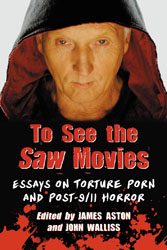 Title of interest – To See the Saw Movies: Essays on Torture Porn and Post-9/11 Horror, edited by James Aston and John Walliss (McFarland, 2013).
Title of interest – To See the Saw Movies: Essays on Torture Porn and Post-9/11 Horror, edited by James Aston and John Walliss (McFarland, 2013).
The Saw films, often derided by critics as “torture porn” and an excuse to show blood and gore, are the highest-grossing horror series in cinema history. In view of their hold on audiences and their controversial content, they deserve study. This first collection of fresh essays by academic authors from Europe, America and Australia addresses the cultural, religious and philosophical facets of the films, investigating how the franchise reflects a post-9/11 shift in U.S. popular culture towards increasing pessimism and how it may be read as a metaphor for the “war on terror”; dissecting how the series explores such issues as freewill and determinism; assessing the films’ representations of the body; and applying a Deleuzian perspective to the franchise.
About the Author
James Aston is director of studies for film at the University of Hull. He lives in Worcester, United Kingdom. John Walliss is senior lecturer in criminology in the faculty of sciences and social sciences, Liverpool Hope University, UK.
Titles of Interest: Extraterrestrials and the American Zeitgeist
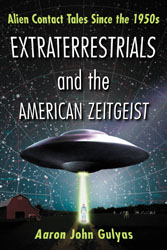 Title of interest – Extraterrestrials and the American Zeitgeist: Alien Contact Tales Since the 1950s
Title of interest – Extraterrestrials and the American Zeitgeist: Alien Contact Tales Since the 1950s
by Aaron John Gulyas (McFarland, 2013).
Since the 1950s, men and women around the world have claimed to have had contact with human-like visitors from space. This book explores how the “contactee” subculture has critiqued political, social and cultural trends in the United States, Europe and elsewhere. Not merely quaint relics of the 1950s Atomic Age, contactees have continued their messages of transformation into the 21st century. Regardless of whether these alleged contacts took the form of physical meetings or channeled paranormal psychic communications, or whether they actually happened at all, contactees have provided a consistently relevant source of commentary on this world and beyond.
About the Author
Aaron John Gulyas is a history instructor at Mott Community College in Flint, Michigan, where he specializes in the modern history of the United States and American military history.
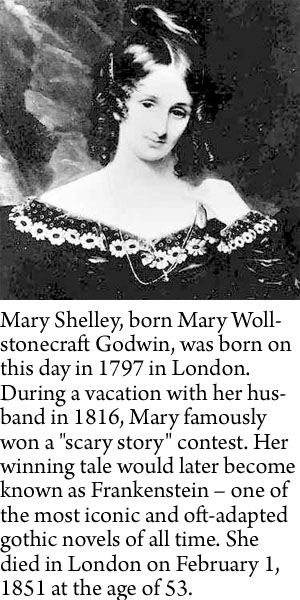
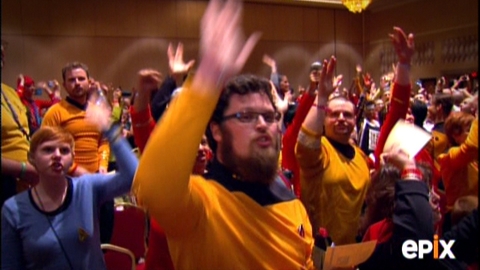
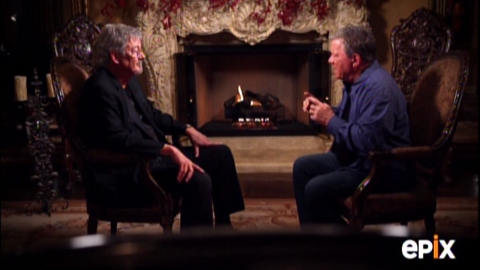






Elysium: Social Commentary and the Interpretive Factor in the System Reboot
Story Summary
Elysium is a dystopian science fiction film set in the year 2154. The citizens of the planet are divided by class, with the vast majority still living on an Earth that resembles the current Majority World, worsened by overpopulation, crime, and environmental decay. The smaller remaining portion of humanity, the wealthiest and most influential, live in orbit on a posh space station called Elysium, where they have access to all the benefits that their social status provides, including advanced healthcare with the ability to cure even the most deadly of diseases and conditions. The political and business rulers of Elysium ensure that a strict separation is kept between the “haves and the have nots,” as citizenship is granted to a select few and confirmed by a bodily branding intertwined with the individual’s DNA. Those from the Earth who want to escape for a better life, and attempt to illegally emigrate to Elysium, are either quickly arrested and deported, or find their ship destroyed in space before it can reach its destination.
Having set the broader social context, the story then introduces two young children, Max (as an adult, played by Matt Damon) and Frey (as an adult, played by Alice Braga), who meet and develop a deep friendship while sharing their desires to one day make it to the Elysium they watch in orbit from their squalor on Earth. The two vow to be together forever, and Max pledges to Frey that one day he’ll help them both reach their utopian desires through Elysium. Fast forward to their adult lives, and Max is holding down a job manufacturing droids, and Frey hasn’t been seen for years, until Max has a violent encounter with police droids who break his arm in connection with his alleged parole violation. After seeking medical care Max connects once again with Frey who works in a hospital providing what meager medical care is possible on Earth without access to the technology of Elysium. Later, Max has a workplace accident, and is exposed to a lethal dose of radiation, with only five days left to live. The drive to survive leads him to pick up the criminal ways of his past, and he seeks out “Spider,” a character who steals Elysium citizens’ identification to support attempts at illegal immigration on the space station. Max agrees to one more job for Spider, and is fitted with an exoskeleton to strengthen his weakened body, and given the task of hijacking the high security computer technology of Elysium stored in the brain of one of its leading citizens and businessmen. Elysium is ultimately the story of a criminal turned savior who begins his journey in order to save his own life, but eventually fulfills his destiny in trying to provide a reboot of the entire social structure of humanity.
Commentary
This film is a worthy successor to Blomkamp’s previous film District 9. It combines science fiction storytelling and a believable script with good performances. It also incorporates a surprising amount of violence and gore, which takes things up a notch from what might be expected in a more traditional science fiction film. Elysium does involve problematic elements, such as one section of the film where Max is fitted with an exoskeleton to help him overcome the debilitating effects of radiation poisoning, and to improve his physical abilities as a mercenary. The technology is fused to his body, including his central nervous system via his skull and spine, not by medical technicians under clean conditions with medical instruments, but instead, by criminals working in the most unsanitary of environment with knives and drills. Not only is the surgery successful, but Max experiences no unsavory side effects from this most improbable of medical efforts.
Combining the good and the not so good, Elysium does all of this while also not giving in to spectacle over substance. In District 9, Blomkamp addressed racism and apartheid. With Elysium, the director taps into the modern zeitgeist and tackles a much broader range of social issues, including class warfare, wealth inequality and distribution, universal healthcare, illegal immigration, as well as workplace occupational safety, and current social debates over liberty and the “War on Terror.” It also incorporates posthumanism/transhumanism elements.
The major social focus of Elysium is that which played out in 2012 and continuing into the present, concerns of wealth inequality and the divide between the wealthy 1% and the lesser fortunate 99%. This was evident in the trailers for the film prior to its release, and although Matt Damon has said the film is not an allegory, and that Blomkamp did not want to beat viewers over the head with social critique, it is heavy handed and has led to division among reviewers. Progressives have tended to resonate with the film, as exemplified by Jonathan Kim in a piece for The Huffington Post, whereas conservatives, like Glenn Beck, have tended to decry the film as a “socialist thriller.” Despite the divide in interpretation of the film, it does provide a way for reflection on important topics. As with all good science fiction, it incorporates “cognitive estrangement” which gives the viewer the critical distance necessary to reflect in new ways on controversial material. Although Blomkamp is less than subtle in his social commentary (although no more so than 2011’s In Time), which compromises some of the effectiveness of the cognitive estrangement in this film, nevertheless, it does raise important issues for careful reflection across an ideological spectrum.
Consider a few examples.
Illegal immigration. Immigration comes to mind as three space ships make their way with non-citizens from the surface of the Earth to Elysium. Since the Earth-bound aspects of the film takes place in 2154 in Los Angeles, it is not surprising to find a largely Hispanic population, and Spanish as the dominant language spoken in the ghettos. As the ships filled with Hispanic illegal immigrants make their way toward Elysium, and later as one successfully lands and as its inhabitants flee and are tracked by infrared and other technology used by “Homeland Security” droids, our present political debates in the U.S. over immigration policy immediately comes to mind.
Universal healthcare. On Elysium, medical technology has advanced to the place where even cancer, leukemia, and a lethal does of radiation, can be overcome by advanced computer scanning and treatment. These scanning and healing beds are not found at special hospitals, but instead are featured within the homes of the wealthy. All one needs is citizenship, which provides access that the wealthy have, but the poor do not. The continued battles between segments of the legislative and executive branches of the U.S. government over the implementation of “Obamacare” and universal healthcare are echoed in this facet of Elysium.
Liberty and the “War on Terror.” During the film, Delacourt (Jodie Foster), who is tasked with overseeing the security of Elysium, makes the argument that extreme measures need to be taken to protect the “liberty” of the citizens of Elysium and the threat to their way of life, even to the point of the destruction rather than deportation of illegal immigrants. Such instances not only echo our cultural debates over concerns about the alleged erosion of personal liberties, but also about the types of actions and their extent that should be taken not only in regards to illegal immigration, but also the “War on Terror.”
System Reboot: The Interpretive Factor
As progressives, conservatives, moderates and everyone else in between continue the discussions and debates about these and other significant social issues featured in Elysium, serious questions arise about how the film’s ending and seeming answer to the problems are to be understood depending upon the context and frame of reference of interpretation.
On the one hand, Americans from the 99% are likely to interpret the film from an American context. At the conclusion of the film (spoiler alert!), Matt Damon’s head contains the stolen computer data and program that will reboot the entire system of Elysium, and make citizens of everyone, including the 99% on the Earth’s surface. Interpreted from this perspective and applied to America, the prescription for moving ahead entails rebooting America’s wealth distribution so that it is somehow made available more evenly among everyone, including access to the best healthcare available. Regardless of the sustainable economic considerations involved, this is a very American perspective on the issue, and one with which those in the rest of the world might well disagree.
Another interpretive possibility (and more likely one) is that Elysium is not understood as a tale of disparity between American citizens, but instead the world. From this perspective Elysium is America, and the 99% represent the rest of the world’s population, particularly the Majority World. This means that the system reboot does not merely involve a redistribution of America’s wealth among it’s citizens, but the wealth of America and other wealthy Western nations among the citizens of the world. Is this interpretation as appealing to Americans who might prefer a political and economic reboot limited to America on behalf of its citizenry?
How do we solve the challenges of the “haves and the have nots?” Is a system reboot the answer, financially and perhaps politically as well? If so, from what perspective to we aim at a reboot, nationally or internationally? Elysium raises important issues and provides a possible solution, but how that is interpreted and applied is as important as the challenges the reboot is designed to fix.
Present public discourse is polarized and divisive. Attempts at understanding the perspectives of those with whom we disagree are few and far between, especially sympathetic ones. But the challenges we face on a number of fronts are serious ones, both in terms of those in America, and those by citizens of other nations. Elysium continues in the tradition of intelligent science fiction past and present in providing commentary on contemporary social issues and challenging us to reflect on them self-critically. Whatever one’s perspective on Elysium, and regardless of where the reader falls on the political and ideological spectrum, perhaps the serious challenges we face might trump our usual divides so that we can enter into meaningful conversations and make the compromises necessary to forge real solutions to what ails us.